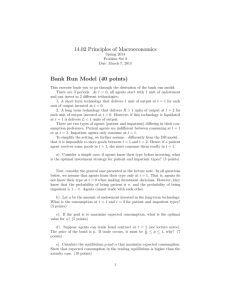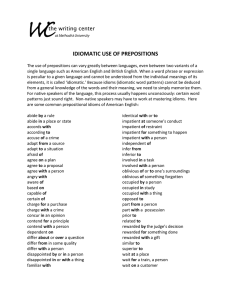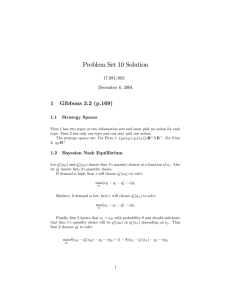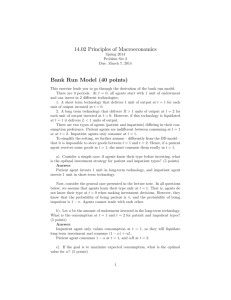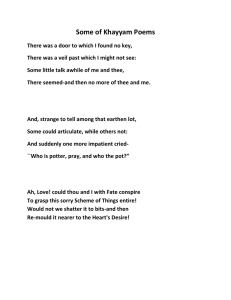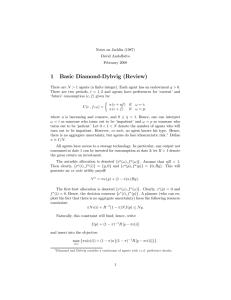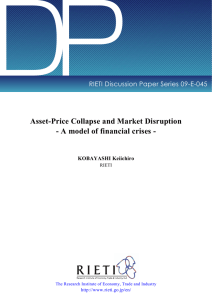Financial Fragility D. Andolfatto
advertisement
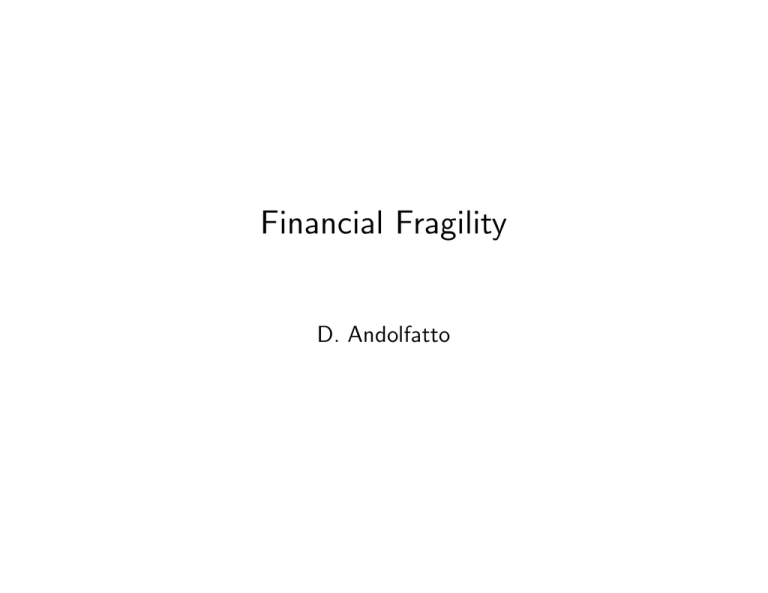
Financial Fragility D. Andolfatto Diamond-Dybvig 1983 Let (c1; c2) denote consumption in period 1; 2 (early, late). Continuum of agents, ex ante identical, ex post “impatient” or “patient.” Impatient agent wants c1, patient agent wants c2. Let 0 1 denote probability of impatience, so ex ante preferences U = u(c1) + (1 0< )u(c2) < 1 is prob. that agent wants to consume early, realized at t = 1: Invoke some LLN, so that is fraction of impatient. Agents each endowed with y units of output. Two storage technologies, short (x) and long (k); with x + k = y: Short-term project can be rolled over at zero interest. Long-term project yields gross return R > 1 in late period and 0 in early period (scrap value) if “liquidated” early. Investment must be made before type realizations. <1 Planning problem is max U s.t. x + k = y; c1 = x and (1 or c2 c1 + (1 ) y R Solution is given by u0(c1) = Ru0(c2) c1 + (1 )c2=R = y Note that R > 1 implies c1 < c2: If cu00(c)=u0(c) > 1 then y < c1 < c2 < Ry: )c2 Rk; Complete markets allocation Assume contingent claims (insurance) market. – two goods are “consumption if impatient” and “consumption if patient.” Let (p1; p2) denote price of early and late consumption, measured in units of endowment. Then budget constraint is given by p1c1 + p2c2 y FOC given by: u0(cd1 ) = 1 p1 0 d p2 u (c2 ): Claim against c1 generates unit revenue p1 and unit cost ; so competition implies p1 = : Claim against c2 generates unit revenue p2 and unit cost (1 competition implies p2 = (1 )=R: )=R; so Substituting these latter equilibrium conditions into FOC condition yields u0(cd1 ) = Ru0(cd2 ) and cd1 + (1 Which implies cd1 = c1 and cd2 = c2: )cd2 =R = y Incomplete markets allocation Assume no insurance market. Ex ante, agents can still invest in short and long investments. Ex post, impatient agents can sell their long investments and patient agents can sell their short investments. Let denote the price of period 2 output measured in units of period 1 output. Ex ante, agents choose identical (x; k); hence ex post have same wealth x + Rk: State-contingent budget constraints are c1 c2 x + Rk x + Rk Choice problem given by max u ((1 x R) x + Ry ) + (1 )u (1 R) x + Ry If R < 1; then soln x = 1; if R > 1; then soln x = we must have = 1=R and c^1 = y and c^2 = Ry: ! 1; so in eqm Bank allocation An alternative way to implement the complete markets allocation. Additional assumption: types are private information. Agents form a risk-sharing arrangment, pool (“deposit”) y; invested in assets x = c1; k = (1 )c2: Liability structure: agents can ask for c1 at date 1 or a pro rata share of remaining resources at date 2. – demand deposit liability. Allocation cannot be conditioned on actual type, but can be conditioned on reported type. Imagine that agents play a “revelation game” where the action is to report their type. Strategy entails a report that is conditional on how others will play (truthfully or not). Imagine a simultaneous-move game and limit attention to pure strategies. Then truth-telling is an equilibrium (Bayes-Nash). Financial fragility One notion of “fragility” relates to the existence of multiple equilibria. In the present context we might ask whether other outcomes are possible? To answer this, we need to be more explicit about the game form (i.e., what possibilities exist “out of equilibrium?”). In particular, what happens if agents misrepresent themselves? Note: in the present context, it never pays for an impatient agent to misrepresent, so we only have to worry about patient types. Bank run Suppose a patient agent believes that all others report “impatient” (i.e., patient agents are mispresenting themselves en masse). Liquidation value of bank’s assets x + k y: If c1 > x + k; then bank cannot honor all early redemption requests. Assume that bank is programmed to set withdrawal limit to w = x + k in the event of a run (and assume agents withdraw maximum amount, conditional on withdrawing). If impatient withdraw w; they consume c^1 = w < c1 (haircut). If patient withdraw w; assume they get to store it and consume c^2 = w < c2 (if they do not withdraw early, they receive zero). In this case, all agents representing themselves as impatient is also an equilibrium (bank run equilibrium). Let denote probability of bank run so expected value of bank (1 For su¢ ciently low allocation. ) [ u(c1) + (1 )u(c2)] + u(w) and high w; bank is preferred to incomplete market Sequential service First-come, …rst-served (usually at …xed price) is ubiquitous in retail settings. Featured prominently in bank run literature, but example above implies not necessary. Induces a sequential game where depositors form a queue and make withdrawal decisions (report types) sequentially. First-period allocation can (in principle) be made contingent on report history, but generally is not. Induces a lottery over withdrawals (early arrivals withdraw c1 until resources depleted, late arrivals receive zero). Normally, But now agents consume c1 = x : agents consume c1 = x + k = w y: If patient agent can costlessly store withdrawal c1; then payo¤ to lying if all others are is given by u(c1) + (1 )u(0) > u(0) Without sequential service, the relevant comparison was u(w ) > u(0): Preventing bank runs The incomplete markets allocation can be interpeted as a form of narrow banking (requirement that dem. liabilities are fully backed, i.e., c1 y ): As it turns out, modifying the deposit contract to include a suspension clause can eliminate the bank run equilibrium. Suppose bank commits to suspending redemptions after resources x exhausted (so commit to no liquidation). – then truth-telling is dominant strategy for patient agents. – solution depends critically on whether bank can make this promise credible (doubtful). Deposit insurance? Interbank lending market? Central bank lender of last resort?

